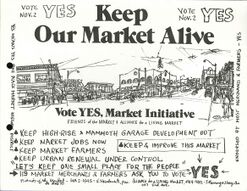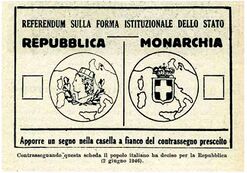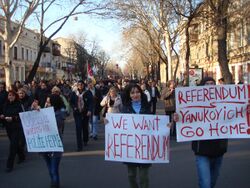Referendum
Topic: Social
 From HandWiki - Reading time: 13 min
From HandWiki - Reading time: 13 min
Ballots for the 2016 Ivorian constitutional referendum; Flyer for a 1971 Seattle referendum; The 1946 referendum in Italy deciding on republic or monarchy.
A referendum (pl.: referendums or less commonly referenda) is a direct vote by the electorate on a proposal, law, or political issue. This is in contrast to an issue being voted on by a representative. This may result in the adoption of a new policy or specific law, or the referendum may be only advisory. In some countries, it is synonymous with and also known as plebiscite, votation, popular consultation, ballot question, ballot measure, or proposition.
Some definitions of 'plebiscite' suggest it is a type of vote to change the constitution or government of a country.[1] The word, 'referendum' is often a catchall, used for both legislative referrals and initiatives.
Etymology
'Referendum' is the gerundive form of the Latin verb referre, literally "to carry back" (from the verb ferre, "to bear, bring, carry" plus the inseparable prefix re-, here meaning "back"[2]). As a gerundive is an adjective,[3] not a noun,[4] it cannot be used alone in Latin, and must be contained within a context attached to a noun such as Propositum quod referendum est populo, "A proposal which must be carried back to the people". The addition of the verb sum (3rd person singular, est) to a gerundive, denotes the idea of necessity or compulsion, that which "must" be done, rather than that which is "fit for" doing. Its use as a noun in English is not considered a strictly grammatical usage of a foreign word but is rather a freshly coined English noun, which follows English grammatical usage, not Latin grammatical usage. This determines the form of the plural in English, which according to English grammar should be "referendums". The use of "referenda" as a plural form in English (treating it as a Latin word and attempting to apply to it the rules of Latin grammar) is unsupportable according to the rules of both Latin and English grammar. The use of "referenda" as a plural form is posited hypothetically as either a gerund or a gerundive by the Oxford English Dictionary, which rules out such usage in both cases as follows:[5]
Referendums is logically preferable as a plural form meaning 'ballots on one issue' (as a Latin gerund,[6] referendum has no plural). The Latin plural gerundive 'referenda', meaning 'things to be referred', necessarily connotes a plurality of issues.[7]
It is closely related to agenda, "those matters which must be driven forward", from ago, to impel or drive forwards; and memorandum, "that matter which must be remembered", from memoro, to call to mind, corrigenda, from rego, to rule, make straight, those things which must be made straight (corrected), etc.
The term 'plebiscite' has a generally similar meaning in modern usage and comes from the Latin plebiscita, which originally meant a decree of the Concilium Plebis (Plebeian Council), the popular assembly of the Roman Republic. Today, a referendum can also often be referred to as a plebiscite, but in some countries the two terms are used differently to refer to votes with differing types of legal consequences.[8]
In Australia, a 'referendum' is often said to be a vote to change the federal constitution and 'plebiscite' a vote which does not affect the federal constitution.[8] However, this is erroneous as not all federal referendums have been on constitutional matters (such as the 1916 Australian conscription referendum), and state votes that likewise do not affect either the federal or state constitution are frequently said to be referendums (such as the 2009 Western Australian daylight saving referendum). Historically, they are used by Australians interchangeably and a plebiscite was considered another name for a referendum.[9][10][11]
In Ireland, 'plebiscite' referred to the vote to adopt its constitution, but a subsequent vote to amend the constitution is called a 'referendum', as is a poll of the electorate on a non-constitutional bill.
History
The name and use of the 'referendum' is thought to have originated in the Switzerland canton of Graubünden as early as the 16th century.[12][13]
After a reduction in the number of referendums in the Mid-twentieth century, the referendum as a political tool has been increasing in popularity since the 1970s. This increase has been attributed to dealignment of the public with political parties, as specific policy issues became more important to the public than party identifiers.[14]
Types of referendums
Classification
The term "referendum" covers a variety of different meanings, and the terminology is different depending on the us that holds them. A referendum can be binding or advisory.[15] In some countries, different names are used for these two types of referendum. Referendums can be further classified by who initiates them.[16]
David Altman proposes four dimensions that referendums can be classified by:[17]
- Mandatory (legally required) vs Optional (ad hoc)
- Binding vs consultative
- Citizen initiated (bottom-up) vs Authorities initiated (top-down)
- Proactive (proposing a change) vs reactive (preventing a change)
Mandatory referendums
A mandatory referendum is a class of referendum required to be voted on if certain conditions are met or for certain government actions to be taken. They do not require any signatures from the public. In areas that use referendums a mandatory referendum is commonly used as a legally required step for ratification for constitutional changes, ratifying international treaties and joining international organizations, and certain types of public spending.[18]
Typical types of mandatory referendums include:
- Constitutional changes: Some countries or local governments choose to enact any constitutional amendments with a mandatory referendum. These include Australia, Ireland, Switzerland, Denmark, and 49 of the 50 U.S. states (the only exception is Delaware).
- Financial referendum: Many localities require a referendum in order for the government to issue certain bonds, raise taxes above a specified amount, or take on certain amounts of debt. In California for example, the state government may not borrow more than $300,000 without a public vote in a statewide bond proposition.[19]
- International relations: Switzerland has mandatory referendums on enacting international treaties that have to do with collective security and joining a supranational community. This type of referendum has only occurred once in the country's history: a failed attempt in 1986 for Switzerland to join the United Nations .[20]
- War referendum: A hypothetical type of referendum, first proposed by Immanuel Kant, is a referendum to approve a declaration of war in a war referendum. It has never been enacted by any country, but was debated in the United States in the 1930s as the Ludlow Amendment.
Optional referendum
An optional referendum is a class of referendums that is put to the vote as a result of a demand. This may come from the executive branch, legislative branch, or a request from the people (often after meeting a signature requirement).
Types of optional referendums include:
- Authorities plebiscite: Also known as a legislative referral, are initiated by the legislature or government. These may be advisory questions to gauge public opinion or binding questions of law.
- Popular initiative or Initiative referendum: A citizen-led process to propose and vote on new laws.
- Popular referendum: A citizen-led process to oppose and strike down existing laws.
- Recall referendum: A procedure to remove elected officials before the end of their term of office. Depending on the area and position, a recall may be for a specific individual, such as an individual legislator, or more general such as an entire legislature.
Rationale
From a political-philosophical perspective, referendums are an expression of direct democracy, but today, most referendums need to be understood within the context of representative democracy. They tend to be used quite selectively, covering issues such as changes in voting systems, where currently elected officials may not have the legitimacy or inclination to implement such changes.
Referendums by country
Since the end of the 18th century, hundreds of national referendums have been organised in the world;[21] almost 600 national votes have been held in Switzerland since its inauguration as a modern state in 1848.[22] Italy ranks second with 78 national referendums: 72 popular referendums (51 of which were proposed by the Radical Party), 4 constitutional referendums, one institutional referendum and one advisory referendum.[23]
Referendums by issue
Civil rights referendum
Financial referendum
Mining referendum
Independence referendum
Referendum design and procedure
Multiple-choice referendums
A referendum usually offers the electorate a straight choice between accepting or rejecting a proposal. However some referendums give voters multiple choices, and some use transferable voting. This has also been called a preferendum when the choices given allow the voters to weight their support for a policy.[24]
In Switzerland , for example, multiple choice referendums are common. Two multiple choice referendums were held in Sweden, in 1957 and in 1980, in which voters were offered three options. In 1977, a referendum held in Australia to determine a new national anthem was held, in which voters had four choices. In 1992, New Zealand held a five-option referendum on their electoral system. In 1982, Guam had a referendum that used six options, with an additional blank option for those wishing to (campaign and) vote for their own seventh option.
A multiple choice referendum poses the question of how the result is to be determined. They may be set up so that if no single option receives the support of an absolute majority (more than half) of the votes, resort can be made to the two-round system or instant-runoff voting, which is also called IRV and PV.
In 2018 the Irish Citizens' Assembly considered the conduct of future referendums in Ireland, with 76 of the members in favour of allowing more than two options, and 52% favouring preferential voting in such cases.[25] Other people regard a non-majoritarian methodology like the Modified Borda Count (MBC) as more inclusive and more accurate.
Swiss referendums offer a separate vote on each of the multiple options as well as an additional decision about which of the multiple options should be preferred. In the Swedish case, in both referendums the 'winning' option was chosen by the Single Member Plurality ("first past the post") system. In other words, the winning option was deemed to be that supported by a plurality, rather than an absolute majority, of voters. In the 1977 Australian referendum, the winner was chosen by the system of preferential instant-runoff voting (IRV). Polls in Newfoundland (1949) and Guam (1982), for example, were counted under a form of the two-round system, and an unusual form of TRS was used in the 1992 New Zealand poll.
Although California has not held multiple-choice referendums in the Swiss or Swedish sense (in which only one of several counter-propositions can be victorious, and the losing proposals are wholly null and void), it does have so many yes-or-no referendums at each election day that conflicts arise. The State's constitution provides a method for resolving conflicts when two or more inconsistent propositions are passed on the same day. This is a de facto form of approval voting—i.e. the proposition with the most "yes" votes prevails over the others to the extent of any conflict.
Other voting systems that could be used in multiple-choice referendum are Condorcet method and quadratic voting (including quadratic funding).
Electronic referendum
Quorum
Quorums are typically introduced to prevent referendum results from being skewed by low turnout or decided by a motivated minority of voters.
Participation quorum
Referendums may require a turnout threshold (also called a participation quorum) in order for the referendum to considered legally valid. In a participation quorum a majority of those voting must approve of the referendum, and a certain percentage of population must have voted in order for the results to be approved.
The usage of participation quorums in referendums is controversial, as higher requirements have been shown to reduced turnout and voter participation.[citation needed] With high participation quorums, the opposition of a referendum has an interest in abstaining from the vote instead of participating, in order to invalidate the referendum results through low turnout. This is a form of the no-show paradox. All others who are not voting for other reasons, including those with no opinion, are effectively also voting against the referendum.
In the 2005 Italian fertility laws referendum, opposition to the proposed loosening of laws on research on embryos and on allowing in-vitro fertilization, campaigned for people to abstain from voting to drive down turnout. Although a majority of people voted yes for the changes in the law, the results were invalid because participation was low.[7]
Referendum disputes
Important referendums are frequently challenged in courts. In pre-referendum disputes, plaintiffs have often tried to prevent the referendum to take place. In one such challenge, in 2017, the Spanish Constitutional Court suspended the Catalonia's independence referendum.[26] In post-referendum disputes, they challenge the result. British courts dismissed post-referendum challenges of the Brexit referendum.[27]
International tribunals have traditionally not interfered with referendum disputes. In 2021, the European Court of Human Rights extended its jurisdiction to referendums in its judgment Toplak and Mrak v. Slovenia, initiated by two disabled voters over polling place access.[28]
Criticisms
Criticism of populist aspect
In Political Governance states that voters in a referendum are more likely to be driven by transient whims than by careful deliberation, or that they are not sufficiently informed to make decisions on complicated or technical issues.[29] Also, voters might be swayed by propaganda, strong personalities, intimidation, and expensive advertising campaigns. James Madison argued that direct democracy is the "tyranny of the majority".
Some opposition to the referendum has arisen from its use by dictators such as Adolf Hitler and Benito Mussolini who, it is argued,[30] used the plebiscite to disguise oppressive policies as populism. Dictators may also make use of referendums as well as show elections to further legitimize their authority such as António de Oliveira Salazar in 1933; Benito Mussolini in 1934; Adolf Hitler in 1934, 1936; Francisco Franco in 1947; Park Chung Hee in 1972; and Ferdinand Marcos in 1973. Hitler's use of plebiscites is argued[by whom?] as the reason why, since World War II, there has been no provision in Germany for the holding of referendums at the federal level.
In recent years, referendums have been used strategically by several European governments trying to pursue political and electoral goals.[31]
In 1995, John Bruton considered that
All governments are unpopular. Given the chance, people would vote against them in a referendum. Therefore avoid referendums. Therefore don't raise questions which require them, such as the big versus the little states.[32]
Closed questions and the separability problem
Some critics of the referendum attack the use of closed questions. A difficulty called the separability problem can plague a referendum on two or more issues. If one issue is in fact, or in perception, related to another on the ballot, the imposed simultaneous voting of first preference on each issue can result in an outcome which is displeasing to most.
Undue limitations on regular government power
Several commentators have noted that the use of citizens' initiatives to amend constitutions has so tied the government to a jumble of popular demands as to render the government unworkable. A 2009 article in The Economist argued that this had restricted the ability of the California state government to tax the people and pass the budget, and called for an entirely new Californian constitution.[33]
A similar problem also arises when elected governments accumulate excessive debts. That can severely reduce the effective margin for later governments.
Both these problems can be moderated by a combination of other measures as
- strict rules for correct accounting on budget plans and effective public expenditure;
- mandatory assessment by an independent public institution of all budgetary implications of all legislative proposals, before they can be approved;
- mandatory prior assessment of the constitutional coherence of any proposal;
- interdiction of extra-budget expenditure (tax payers anyway have to fund them, sooner or later).
Sources
- The Federal Authorities of the Swiss Confederation, statistics (German). Statistik Schweiz - Stimmbeteiligung
- Turcoane, Ovidiu (2015). "A proposed contextual evaluation of referendum quorum using fuzzy logics". Journal of Applied Quantitative Methods 10 (2): 83–93. http://www.jaqm.ro/issues/volume-10,issue-2/pdfs/8_OV_.pdf.
See also
- Electronic referendum
- Referendums by country
- Popular referendum
- Initiative
- Direct democracy
- Right to petition
- Independence referendum
- Deliberative referendum
- War referendum
References
- ↑ "Definition of Plebiscite". Oxforddictionaries.com. http://www.oxforddictionaries.com/definition/english/plebiscite.
- ↑ Marchant & Charles, Cassell's Latin Dictionary, 1928, p. 469.
- ↑ A gerundive is a verbal adjective (Kennedy's Shorter Latin Primer, 1962 edition, p. 91.)
- ↑ A gerund is a verbal noun (Kennedy's Shorter Latin Primer, 1962 edition, p. 91.) but has no nominative case, for which an infinitive (referre) serves the purpose
- ↑ Oxford English Dictionary Referendum
- ↑ a gerund is a verbal noun (Kennedy's Shorter Latin Primer, 1962 edition, p. 91.) but has no nominative case, for which an infinitive (referre) serves the purpose. It has only accusative, genitive, dative and ablative cases (Kennedy's Shorter Latin Primer, 1962 edition, pp. 91-2.)
- ↑ 7.0 7.1 i.e. Proposita quae referenda sunt popolo, "Proposals which must be carried back to the people"
- ↑ 8.0 8.1 Green, Antony (12 August 2015). "Plebiscite or Referendum - What's the Difference". ABC. http://blogs.abc.net.au/antonygreen/2015/08/plebiscite-or-referendum-whats-the-difference.html.
- ↑ "THE REFERENDUM.". Evening News (New South Wales, Australia) (9452): p. 4. 21 September 1897. http://nla.gov.au/nla.news-article108757304.
- ↑ "Government by Plebiscite.". The Sydney Mail and New South Wales Advertiser (New South Wales, Australia) LXV (1960): p. 217. 29 January 1898. http://nla.gov.au/nla.news-article163803818.
- ↑ "The Plebiscite or Referendum.". The Bendigo Independent (Victoria, Australia) (12,464): p. 4. 3 December 1910. http://nla.gov.au/nla.news-article227144727.
- ↑ Barber, Benjamin R.. The Death of Communal Liberty: A History of Freedom in a Swiss Mountain Canton. Princeton University Press, 1974, p. 179.
- ↑ Vincent, J.M.. State and Federal Government in Switzerland, Johns Hopkins University Press, 2009, p. 122
- ↑ Silagadze, Nanuli; Gherghina, Sergiu (January 2020). "Referendum Policies across Political Systems". The Political Quarterly 91 (1): 182–191. doi:10.1111/1467-923x.12790. ISSN 0032-3179.
- ↑ de Vreese, Claes H. (2007). "Context, Elites, Media and Public Opinion in Referendums: When Campaigns Really Matter". The Dynamics of Referendum Campaigns: An International Perspective. Palgrave Macmillan. pp. 2–3. ISBN 9780230591189. https://books.google.com/books?id=wHuGDAAAQBAJ.
- ↑ Serdült, Uwe; Welp, Yanina (2012). "Direct Democracy Upside Down". Taiwan Journal of Democracy 8 (1): 69–92. doi:10.5167/uzh-98412. http://www.tfd.org.tw/export/sites/tfd/files/publication/journal/dj0801/004.pdf.
- ↑ "Direct Democracy Worldwide" (in en). https://www.researchgate.net/publication/288427223.
- ↑ "Design and Political issues of Referendums —". http://aceproject.org/ace-en/topics/es/ese/ese08/ese08a/ese08a02.
- ↑ "Statewide bond propositions (California)" (in en). https://ballotpedia.org/Statewide_bond_propositions_(California).
- ↑ Goetschel, Laurent; Bernath, Magdalena; Schwarz, Daniel (2004) (in en). Swiss Foreign Policy: Foundations and Possibilities. Psychology Press. ISBN 978-0-415-34812-6. https://books.google.com/books?id=4Ok3SLA1ndEC&q=mandatory+referendum+switzerland+treaty+security&pg=PA40.
- ↑ (in French) Bruno S. Frey et Claudia Frey Marti, Le bonheur. L'approche économique, Presses polytechniques et universitaires romandes, 2013 (ISBN:978-2-88915-010-6).
- ↑ Duc-Quang Nguyen (17 June 2015). "How direct democracy has grown over the decades". Berne, Switzerland: swissinfo.ch - a branch of the Swiss Broadcasting Corporation SRG SSR. http://www.swissinfo.ch/eng/explore-600-national-votes_how-direct-democracy-has-grown-over-the-decades/41481992.
- ↑ "Dipartimento per gli Affari Interni e Territoriali". http://elezionistorico.interno.it/index.php?tpel=F.
- ↑ Reybrouck, David Van (2023-03-16). "Democracy's Missing Link: The "preferendum" — a method for citizens to rate and rank policy ideas — would turn citizen concerns into government action." (in en-US). Noema. https://www.noemamag.com/democracys-missing-link.
- ↑ "Manner in which referenda are held". Citizens' Assembly. https://www.citizensassembly.ie/en/Manner-in-which-referenda-are-held/Manner-in-which-referenda-are-held.html.
- ↑ "Spain Catalonia: Court blocks independence referendum" (in en-GB). BBC News. 2017-09-08. https://www.bbc.com/news/world-europe-41196677.
- ↑ "High Court rejects challenge to have Brexit referendum result declared void" (in en). 2018-12-10. https://www.independent.co.uk/news/uk/politics/brexit-high-court-case-legal-challenge-referendum-vote-leave-spending-theresa-may-eu-a8676226.html.
- ↑ "ECHR ruling 'has Europe-wide implications' on disability". https://www.lawsociety.ie/gazette/top-stories/2021/10-october/echr-ruling-has-europe-wide-implications-on-disability.
- ↑ Political Governance: Political theory. Gyan Publishing House. 2005. ISBN 9788182053175. https://books.google.com/books?id=kzV4V59udu8C.
- ↑ Qvortrup, Matt (2013). Direct Democracy: A Comparative Study of the Theory and Practice of Government by the People. Manchester: Manchester University Press. ISBN 978-0-7190-8206-1.
- ↑ Sottilotta, Cecilia Emma (2017). "The Strategic Use of Government-Sponsored Referendums in Contemporary Europe: Issues and Implications". Journal of Contemporary European Research 13 (4): 1361–1376. doi:10.30950/jcer.v13i4.836. https://www.jcer.net/index.php/jcer/article/view/836/781.
- ↑ Bowcott, Owen; Davies, Caroline (2019-12-31). "Referendums are a bad idea, Irish leader told EU in 1995". The Guardian. https://www.theguardian.com/uk-news/2019/dec/31/referendums-are-a-bad-idea-irish-leader-told-eu-in-1995.
- ↑ "California: The ungovernable state". The Economist (London): pp. 33–36. 16–22 May 2009. http://www.economist.com/world/unitedstates/displayStory.cfm?STORY_ID=13649050.
Further reading
- Morel, L. (2011). 'Referenda'. In: B. Badie, D. Berg-Schlosser, & L. Morlino(eds), International Encyclopedia of Political Science.Thousand Oaks: SAGE: 2226–2230.
- Qvortrup, Matt (2017). "Demystifying Direct Democracy". Journal of Democracy 28 (3): 141–152. doi:10.1353/jod.2017.0052. http://www.journalofdemocracy.org/article/rise-referendums-demystifying-direct-democracy.
- Piott, Steven L. Giving Voters a Voice: The Origins of the Initiative and Referendum in America (2003) online
- Qvortrup, Matt; O'Leary, Brendan; Wintrobe, Ronald (2018). "Explaining the Paradox of Plebiscites". Government and Opposition 55 (2): 1–18. doi:10.1017/gov.2018.16.
- Setälä, M. (1999). Referendums and democratic government. London and New York: Palgrave Macmillan.
- Smith, Julie (ed.). 2021. The Palgrave Handbook of European Referendums. Palgrave.
- Topaloff, Liubomir (2017). "Elite Strategy or Populist Weapon?". Journal of Democracy 28 (3): 127–140. doi:10.1353/jod.2017.0051. http://www.journalofdemocracy.org/article/rise-referendums-elite-strategy-or-populist-weapon.
 |
 KSF
KSF





